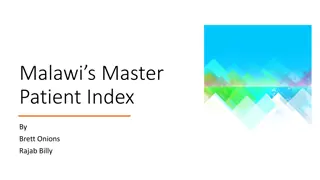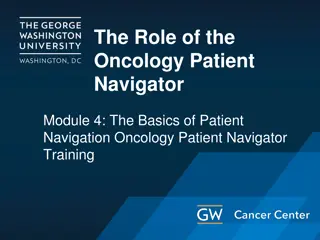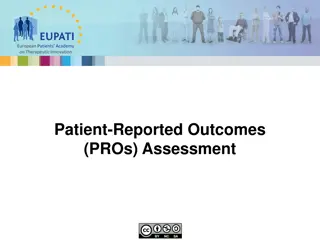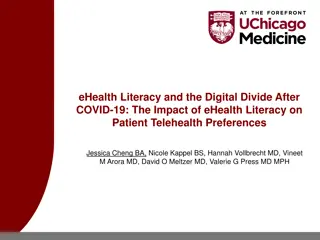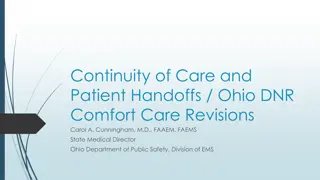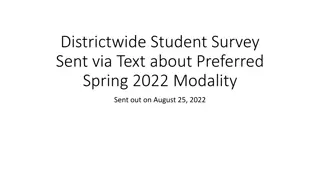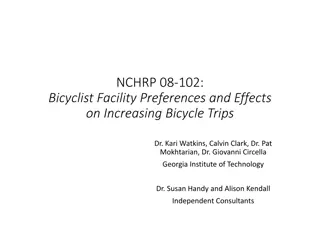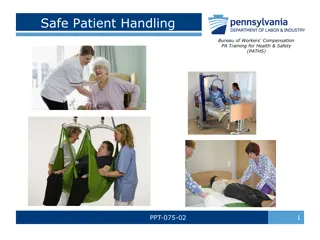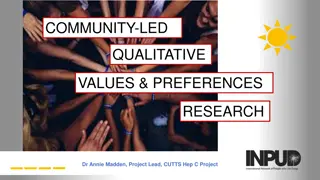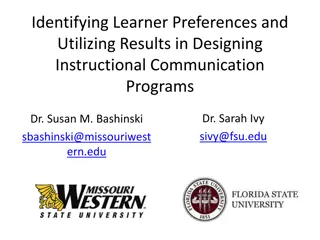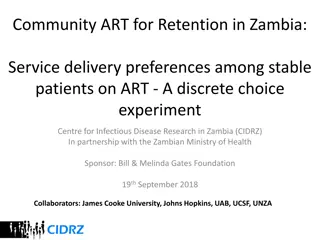Modernize Patient Experience with Digital Patient Conversion Platform
Enhance patient relationships and streamline your practice with a secure digital patient conversion platform. Acquire new patients online, modernize patient experience, retain existing patients, and optimize technology investments. Utilize tools like online booking, digital check-in, and workflow au
0 views • 31 slides
Understanding POLST and Advance Directives in Healthcare Decision-Making
POLST, or Practitioner Orders for Life-Sustaining Treatment, is a healthcare planning tool that empowers individuals to articulate their medical preferences when facing advanced illness. Contrasting with Advance Directives, which are statements of patient intentions, POLST represents actionable medi
2 views • 22 slides
Understanding the Patient Safety Incident Response Framework (PSIRF)
The Patient Safety Incident Response Framework (PSIRF) is set to replace the Serious Incident Framework (2015) within the NHS, marking a significant shift in responding to patient safety incidents. Its key aims include compassionate engagement, system-based learning, proportionate responses, and sup
5 views • 9 slides
World Patient Safety Day 2023: Engaging Patients for Patient Safety
World Patient Safety Day 2023 emphasizes engaging, raising, advocating, and empowering patients for safety in healthcare. Major activities include taking the pledge of "First Do No Harm," promoting patient safety at Health Mela events, recognizing safety champions, and sharing innovative learnings.
6 views • 15 slides
Enhancing Healthcare Services in Malawi through the Master Patient Index (MPI)
The Master Patient Index (MPI) plays a crucial role in Malawi's healthcare system by providing a national patient identification system to improve healthcare quality and treatment accuracy. Leveraging the MPI aims to dispense unique patient IDs, connect with existing registries, enhance data managem
4 views • 8 slides
Rwanda HIE Patient Identity Management System Overview
The Rwanda Health Information Exchange (HIE) system focuses on patient identity management to uniquely identify individuals seeking healthcare across the country. By maintaining a set of identifiers in the client registry and avoiding duplication of patient records, the system ensures efficient and
12 views • 8 slides
Streamlining Healthcare, The Role of Patient Access Services in Medkarma
In the labyrinth of healthcare, where patient needs intersect with administrative procedures, lies a critical component often overlooked \u2013 Patient Access Services. In the realm of Medkarma, this integral function serves as the linchpin, orchestrating seamless transitions from patient inquiries
3 views • 8 slides
Efficient Patient Recruitment and Messaging in MyChart
Streamline your patient recruitment process in MyChart by accessing, finding eligible patients, sending messages, and tracking responses effectively. Learn how to access reports, find and select patients, send recruitment requests, send patient-facing messages, and track patient responses for resear
0 views • 7 slides
Gender Responsive Crop Breeding: Plantain Preferences in Cameroon
Plantains are a significant crop in Cameroon, with a focus on understanding gender preferences for plantain traits. Research conducted in two regions revealed insights on the importance of plantains, decision-making dynamics, and gender-specific preferences. Men exhibited more independence in decisi
0 views • 10 slides
How to Add a Patient to a Custom Patient List in The New EPR
Learn step-by-step instructions on adding a patient to a custom patient list in The New EPR (Electronic Patient Record) system. Follow the detailed guide to efficiently manage patient data and create customized lists for easy access. Enhance your workflow with this quick reference guide.
0 views • 9 slides
Understanding the Role of Oncology Patient Navigators
This content delves into the essentials of patient navigation in oncology, covering competencies, professional roles, responsibilities, and functions of patient navigators. It highlights the importance of patient empowerment, communication, cultural competency, and care coordination. The material al
0 views • 43 slides
Understanding Patient-Reported Outcomes in Therapeutic Innovation
Patient-Reported Outcomes (PROs) are gaining importance in therapeutic innovation to capture how patients feel about their treatment beyond clinical effectiveness. The European Patients Academy emphasizes the significance of measuring PROs through tools like Patient-Reported Outcome Measures (PROMs)
0 views • 30 slides
Organising Nursing Services for Effective Patient Care
This content discusses methods of patient assignment, objectives of organising patient care units, factors influencing patient care quality, and considerations for organising patient care in wards. It emphasizes forecasting needs, professional activities, organizational activities, physical environm
0 views • 45 slides
Understanding the Impact of eHealth Literacy on Telehealth Preferences Post-COVID-19
The research explores the relationship between eHealth literacy and patient telehealth preferences after the COVID-19 pandemic. It highlights disparities in telehealth use among different demographics, emphasizing the importance of digital literacy for accessing healthcare services. The study aims t
0 views • 19 slides
Enhancing Patient Safety: Global Action Plan 2021-2030
Patient safety is a critical aspect of healthcare with millions of adverse events occurring annually. The Global Patient Safety Action Plan (GPSAP) for 2021-2030 focuses on key areas such as policies for zero patient harm, high reliability systems, safety of clinical processes, patient and family en
0 views • 13 slides
Role of Radiology Resource Nurses in Healthcare
In November 2018, the need for Nursing Coverage in the Radiology Department led to the identification of the Role of Radiology Resource Nurses (RRN). These critical care-trained Registered Nurses act as clinical liaisons between patient care areas and the Radiology Department, ensuring continuity of
0 views • 21 slides
Enhanced Recovery Program Implementation in Post-Surgical Nursing
Introducing and implementing an Enhanced Recovery Program (ERP) in post-surgical nursing can significantly improve patient outcomes, experience, and satisfaction. This clinical pathway designed by MSQC aims to optimize patient recovery by standardizing protocols throughout the perioperative care pro
1 views • 26 slides
Enhancing Patient Handoffs and Continuity of Care in EMS Settings
This document discusses the critical aspects of patient handoffs and continuity of care in emergency medical services (EMS) settings. It highlights the challenges faced during patient transitions and emphasizes the importance of effective communication and collaboration between EMS providers and rec
0 views • 14 slides
Exploring TV Shows and Movies Preferences
Engage in discussions about preferences for TV shows and movies, ranging from game shows to comedies, action movies to scary movies. Dive into opinions on educational content, seriousness, and enjoyability, and practice listening skills to understand others' viewpoints. Explore a variety of genres a
0 views • 13 slides
Improving Patient Access to Clinical Care in NYC Correctional Health Services
NYC Health + Hospitals/Correctional Health Services (CHS) has implemented initiatives for patient access to clinical care. CHS offers both CHS-Initiated and Patient-Initiated access to medical appointments. The Patient-Initiated Health Triage Line (HTL) allows direct communication with nurses for no
1 views • 5 slides
Insights into Secondary School Menu Preferences for Autumn-Winter 2020
Exploring the new student-led menu for secondary schools by Food Union in collaboration with Chartwells. Analyzing responses by region to understand why students are not eating at school, addressing issues like long queues and meal preferences. Identifying common food concepts and preferences across
0 views • 22 slides
Privacy-Aware Smart Buildings: Ensuring Privacy Policies and Preferences
Smart buildings equipped with IoT technology raise concerns about privacy. This research explores capturing, communicating, and enforcing privacy policies and preferences in smart buildings, addressing issues like data collection, user preferences, and policy enforcement based on FTC and OECD guidel
0 views • 24 slides
Improving Emergency Department Patient Care with Care at Arrival Model
Emergency Medicine Administrator Travis W. Schmitz introduces the innovative Care at Arrival approach to enhance patient care in the emergency department. The model focuses on providing immediate treatment upon patient arrival to reduce wait times, increase patient satisfaction, and improve operatio
0 views • 12 slides
Understanding Evaluator Personality Preferences in Evaluation Practice
Explore how evaluator personality preferences can impact evaluation design and utilization, and how differences in preferences between evaluators and clients may explain controversies in evaluation practice. The interactive session delves into using personality preferences to inform evaluation desig
0 views • 38 slides
Student Preferences for Spring 2022 Instructional Modality Survey Results
A districtwide student survey was sent out via text to gather preferences for the preferred instructional modality for Spring 2022. The survey targeted currently enrolled SMCCCD students who opted-in to receive text messages, resulting in a 38% response rate. Preferences by primary campus showed var
0 views • 4 slides
Understanding Bicyclist Facility Preferences for Increasing Bicycle Trips
This research study aims to investigate the various preferences and effects of different bicycle facilities on increasing bicycle trips. It explores how individual preferences for bike facilities differ and the effectiveness of these facilities in attracting new trips. The study delves into the impa
0 views • 52 slides
Recent Developments in Unfair Preferences Law
The law on unfair preferences, particularly under Section 588FA of the Corporations Act, addresses transactions where a company favors a creditor, resulting in the creditor receiving more than they would in a winding up process. Recent cases like Cant v. Mad Brothers and Re Emanuel highlight the com
0 views • 27 slides
Ensuring Safe Patient Handling in Healthcare Settings
This presentation discusses the risks of musculoskeletal injuries in healthcare due to manual patient handling, emphasizing the importance of proper techniques and patient lift equipment. It highlights rising challenges such as obesity rates, an aging workforce, and workforce shortages contributing
0 views • 47 slides
Enhancing Patient-Centered Care Through Improved CMC Records at The Hillingdon Hospitals NHS Foundation Trust
The Hillingdon Hospitals Trust aims to enhance patient-centered care by improving visibility and awareness of CMC (Coordinate My Care) records across generic teams through the development of specific patient information resources, tracking patient attendance at ED with CMC records, and optimizing th
0 views • 11 slides
Community-Led Qualitative Research on LDSS/N Distribution Preferences
Dr. Annie Madden leads a community-led research project focused on the values and preferences of people who inject drugs regarding LDSS/N distribution. The study aims to generate evidence on the feasibility and impact of implementing LDSS/N distribution programs, involving phases from pre-implementa
0 views • 8 slides
Understanding Learner Preferences for Effective Communication Programs
Explore learner preferences and their role in designing instructional communication programs. Learn how to assess preferences, promote communication development, and build a strong foundation for effective programs. Discover key concepts such as behavior as communication and the importance of intent
0 views • 65 slides
Enhancing User Experience Through Dynamic Recommendations
In this presentation, the xStreams system is introduced for recommending items to users with changing preferences. The methodology involves learning user preferences, finding similar users, and providing item recommendations. The motivation behind the system includes dealing with vast amounts of dat
0 views • 27 slides
Engaging English Lesson on Sports Preferences
In this English lesson for Class Five students, the focus is on discussing sports preferences. The lesson introduces Tania, who enjoys various sports activities like swimming, cycling, and football. Students will learn how to engage in conversations about favorite sports, express likes and dislikes,
0 views • 18 slides
Techniques for Building Patient Rapport in O&P Clinics
Explore essential terminology and techniques for enhancing patient rapport in orthotics and prosthetics (O&P) clinics. Learn about treatment planning based on patient diagnosis and assessments, conducting effective patient interviews, and engaging patients through communication strategies. Discover
1 views • 48 slides
Factors Influencing Delayed Prescribing in UK Primary Care
Factors influencing delayed prescribing in UK primary care were examined through a study involving general practitioners (GPs) and prescribing scenarios for respiratory tract infections. Clinical features, patient preferences, and practitioner tendencies were key factors affecting the decision to pr
0 views • 5 slides
Exploring Doll Preferences Among Children in Kindergarten Library
In this educational activity, children are prompted to identify and label different types of dolls traditionally associated with specific genders, such as girls liking girl dolls and boys liking boy dolls. They engage in a hands-on task of matching names to dolls through drag-and-drop interactions.
0 views • 4 slides
Insights from 2nd International Seminar on End-of-Life Care Preferences in Europe
The 2nd International Seminar highlighted findings on actual and preferred places of death in four European countries, emphasizing the importance of patient-centered care, societal costs, and public policies. Winne Ko presented EURO IMPACT studies showing the use of proxies and GP networks to gather
0 views • 15 slides
ePAG Steering Committee Governance Update Summary
The ePAG Steering Committee is working on governance aspects and templates for ePAGs, focusing on patient engagement and transparency. The committee aims to establish clear requirements for patient organizations, formalize relationships between ERNs and patient organizations, and integrate rules for
0 views • 10 slides
Service Delivery Preferences Among Stable HIV Patients in Zambia
A study conducted in Zambia explored the service delivery preferences of stable patients on antiretroviral therapy (ART) through a discrete choice experiment. The research focused on the benefits of differentiated service delivery, gaps in knowledge regarding patient preferences, and demographic cha
0 views • 9 slides
Understanding Consumer Preferences and Utility Concepts in Economics
In economics, analyzing consumer preferences and utility is crucial for understanding how individuals make choices and maximize their well-being within budget constraints. This includes concepts like complete preferences, transitivity, and monotonicity. By examining how consumers rank different bask
0 views • 36 slides




